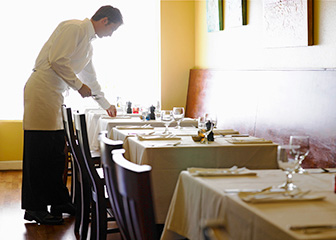Summary

| Quick Facts: Food and Beverage Serving and Related Workers | |
|---|---|
|
$18,130 per year
$8.72 per hour |
|
| Less than high school | |
| None | |
| See How to Become One | |
| 4,110,400 | |
| 12% (About as fast as average) | |
| 491,600 | |
What Food and Beverage Serving and Related Workers Do
Food and beverage serving and related workers perform a variety of customer service, food preparation, and cleaning duties in full-service restaurants, casual dining eateries, and other eating and drinking places.
Work Environment
Food and beverage serving and related workers are employed in restaurants, schools, hospitals, cafeterias, and other dining places. The majority work part time, which often includes early mornings, late evenings, weekends, and holidays.
How to Become a Food and Beverage Serving or Related Worker
Most food and beverage service jobs are entry level and do not require a high school diploma. The majority of workers receive short-term on-the-job training.
Pay
The median hourly wage of food and beverage serving and related workers was $8.72 in May 2010.
Job Outlook
Employment of food and beverage serving and related workers is projected to grow 12 percent from 2010 to 2020, about as fast as the average for all occupations. Job opportunities at most eating and drinking places will be excellent, because many people in these occupations change jobs frequently, resulting in a large number of openings.
Similar Occupations
Compare the job duties, education, job growth, and pay of food and beverage serving and related workers with similar occupations.
O*NET
O*NET provides comprehensive information on key characteristics of workers and occupations.
Contacts for More Information
Learn more about food and beverage serving and related workers by contacting these additional resources.








